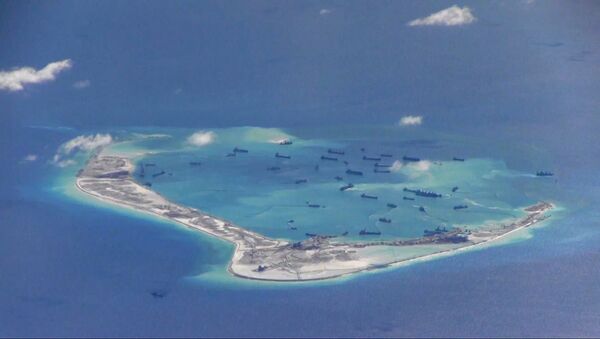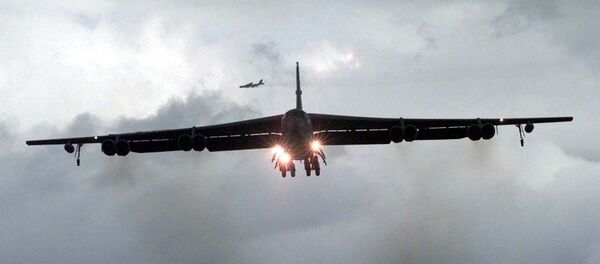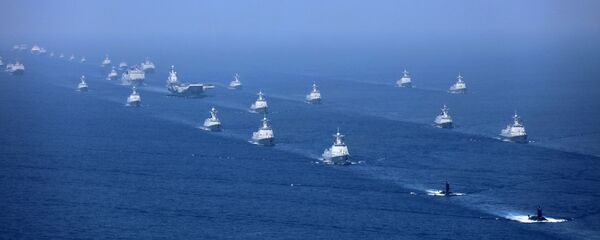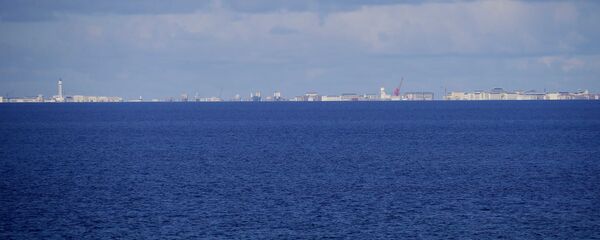During the 2019 Langkawi International Maritime and Aerospace Exhibition (LIMA) in Malaysia last week, the China Electronics Technology Group Corporation (CETC) unveiled a new offshore platform with two variants for use in the South China Sea.
The new system can be configured as a floating integrated information platform (IIFP) and or a more powerful island reef-based integrated information system (IRBIS). Both models are designed to be unmanned and provide a variety of methods for monitoring weather, the seas and human activity in the area. They're lightweight and can be deployed in shallow water by tugboat or other similar vessels, according to China Military Online.
The IIFP can serve as a 4G or shortwave communication base station, tsunami early warning facility and auxiliary navigation service, China Military Online reported. The larger IRBIS can do the same, but hosts much more powerful and numerous sensors.
However, China's Ministry of National Defense frankly admitted the platforms could also provide "continuous surveillance of [an] offshore target," and might play important roles in "the construction on China's Nansha and Xisha Islands, defending the islands and reefs, and continuous monitoring of targeted waters."
Beijing identifies 90 percent of the South China Sea as its territory, laying claim to the islands and reefs therein, including the Spratly (Chinese name Nansha) and Paracel (Chinese name Xisha) Islands. These islands range from spits of land enlarged by Chinese construction to territories completely reclaimed from the sea by building up underwater reefs to sit above sea level. Powers such as the US and UK refuse to recognize these islands as Chinese territory and send their warships through the waterway despite Beijing's warnings in what the US Navy calls "freedom of navigation operations" or FONOPS.
Five other nations also claim parts of the South China Sea: Vietnam, Taiwan, Malaysia, Brunei and the Philippines — a contentious issue with potentially huge economic consequences for the winners and losers, as enormous hydrocarbon reserves are believed to lie beneath the sea floor.
While the waterways' numerous reefs, shallows and islands undoubtedly provide an enormous amount of nautical hazards for ships traversing it — and no small number do so, with roughly $3 trillion in trade passing through each year — the platforms could also serve the important political role of amplifying Beijing's ability to patrol the vast sea.
Maritime Militia: ‘An Inexpensive Force Multiplier'
China's maritime militia is a unique paramilitary naval force that "provides the People's Liberation Army Navy (PLAN) with an inexpensive force multiplier," James Kraska, a professor and research director in the Stockton Center for the Study of International Law at the US Naval War College, wrote in The Diplomat in August 2015. The force is based on the dual use of a sizeable portion of China's 200,000-strong civilian fishing fleet. The country's commercial fishing industry employs 14 million people — one quarter of the world's total fishers — making it a potentially potent maritime weapon during a time of war.
"Using fishing vessels as naval auxiliaries violates the principle of distinction," Kraska wrote, "a key tenet of international humanitarian law (IHL), which prescribes that civilians and civilian objects should be protected from armed attack. The entire purpose of the principle of distinction is to protect civilians and ameliorate the effects upon them of warfare. The central purpose of the principle of distinction is to ameliorate the effects of warfare upon civilians, but China's maritime militia blurs beyond recognition the line between fishing vessels and naval functions."
Kraska warns that the maritime militia "may make fishing vessels lawful targets during armed conflict, with potentially tragic consequences for legitimate fishermen from China and nearby states," calling this a "perversion of legal concepts or processes to counter an opponent."
"The maritime militia exploit seams in the law and thereby place at risk the very civilians that the law is made to protect," the expert wrote.
"China is trying to use these government-controlled fisherman below the radar to get the bonus without the onus to support its South China Sea claims," Andrew Erickson, an associate professor at the US Naval War College, told Defense News in a November 2015 interview.
The Diplomat noted the platforms will compliment the network of sensors already installed on key South China Sea islands, such as Woody Island and Fiery Cross Reef, and will help it to expand its control over as-yet unreclaimed nautical landmarks like Scarborough Shoal, a point of sharp contestation between Beijing and Manila.
While China's Coast Guard and maritime militia are enormous by world standards, even they can't provide the kind of patrolling coverage necessary for Beijing to truly exert exclusive control over the South China Sea. The Diplomat notes they have just one vessel for roughly every 2,700 square miles of water over which they lay claim — but that's where these platforms will come in handy, by providing up-to-date information necessary to more effectively deploy water forces to problem areas.
At a February speech at the Washington-based Atlantic Council think tank, Chief of US Naval Operations Admiral John Richardson highlighted the unique problems posed by the maritime militia, which he referred to as "gray zones" not clearly governed by the United Nations Convention on the Law of the Sea or the US Navy's Code of Unplanned Encounters at Sea.
His comments were prompted by increasingly tense exchanges between Chinese vessels and US Navy ships engaging in FONOPS, including one in September 2018 when US and Chinese destroyers came only a couple dozen yards from colliding, as well as increasingly suggestive military drills and demonstrations in and near the waterway.
"So let's not be obstructing one another, driving our ships in front of one another, throwing obstacles in front of the ship. Let's just be biased towards making it easy," Richardson said, according to USNI. "[T]hese rules have to apply to all of the forces — so it can't just be the People's Liberation Army Navy to which they apply, but it's also got to be the [China] Coast Guard, and it's also got to be the maritime militia, and everybody's got to abide by these. Being more insistent about those would be a good first start."









